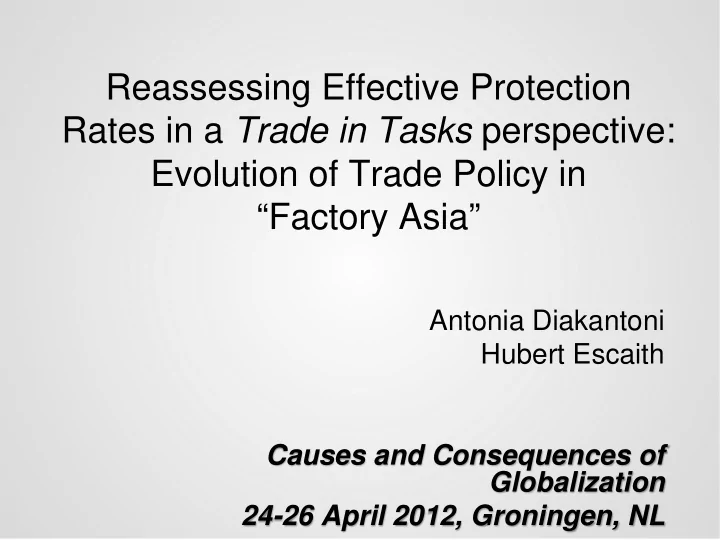

Reassessing Effective Protection Rates in a Trade in Tasks perspective: Evolution of Trade Policy in “Factory Asia” Antonia Diakantoni Hubert Escaith Causes and Consequences of Globalization 24-26 April 2012, Groningen, NL
Effective Protection Rates (EPRs): What, Why? • History, limitations – EPRs as analytical indicator of tariff escalation – EPRs associated to the production function – Poor predictive power due to fixed factor proportions (Leontief technology using I-O matrices) • EPR revival – International trade moves from "trade in (final) goods" to "trade in tasks" – Vertical specialization and trade in value added perspective – New sets of IO data and their linkages
Effective Protection Rates (EPRs): Properties
I.a The data • International input-output – 10 economies: China, Indonesia, Japan, Korea, Malaysia, Philippines, Singapore, Chinese Taipei, Thailand, and the USA – 3 reference years 1995, 2000 and 2005 (estimate) – 76 sectors of activity, aggregated into 64 sectors to match the tariff data Source: Institute of Developing Economies, JETRO and WTO estimates • Tariff line MFN applied duties and import statistics – Calculation of NPs: weighted tariff averages by product and partner at the HS 6-digits, aggregated at the sector level – 3 reference years 1995, 2000 and 2005, MFN applied rates – 53 good-producing sectors and partners (10 plus RoW) – Standard concordance tables (versions of the HS - correlate HS tariff data to the ISIC industrial sectors) Source: WTO Integrated Data Base (IDB)
I.b The method • Initial data exploration - Value added, Nominal protection and EPRs - Developed / developing countries - Time and sectoral dimensions • Detangling structural and tariff effects – Changes in trade policy (nominal tariff schedule) vs. – Changes in inter-industrial productive structure (input-output matrix)
I.b The method cont’d • Detangling nominal exchange rates and inflation effects • Law of one price (constant real exchange rate): (1) Imported inputs move as international inflation and changes in nominal exchange rate vis à vis the US dollar. (2) Domestic inputs move as the domestic rate of inflation. both (1) and (2) should move in parallel in the long term, but …
Domestic and imported content of exports, share • Proportion changes with country size, development level and output composition • Magnitudes increased globally and shares remain balanced • Domestic intermediate input contents of exports are predominant, 90 % in agriculture and raw materials and 72% in manufactures
Domestic and imported content of exports (gross, % of total output value) No systematic one to one complementarity between imported and domestic inputs (variations in rate of value-added per unit of output)
Towards lower EPRs AGRICULTURE MANUFACTURES DVG DVG DVG DVD 1995 NP EPR NP EPR NP EPR NP EPR Median 6.5 4.9 1.3 0.9 9.2 14.7 2.3 3.5 Mean 27.2 29.6 2 1.1 15.9 26.3 4 8.3 2005 Median 3.9 2.6 1.9 3.1 6.2 10.6 1.3 1.8 Mean 11.9 15.5 2.1 3.9 7.8 16.6 2.9 5.8 Changes are more significant : … for developing countries (DVG) than developed (DVD) … for the mean than for the median (reduced level and dispersion of nominal and effective tariff protection rates)
Simulations: changes in tariff policy or in production structure D=P observed; D<P duties (D) older than production patterns and vice versa Source: Table 8
Simulations: changes in tariff policy or in production structure D=P observed; D<P duties (D) older than production patterns and vice versa Source: Table 8
Adjusted and non adjusted EPRs for exchange rate and inflation effects (comparison with 1995) Basic idea: no change if domestic prices and xrate followed the law of constant PPP Impacts of the 1997 Asian crisis: differentiated and slowly absorbed
Average Propagation Length (APL) of a Tariff Hike • The scale of the impact depends on the length of the supply chain; in an input-output setting, a rough measure of the depth of supply chains could be given by the average propagation length (APL) of a shock. • an inverse Leontief or Ghosh matrix to trace both direct and indirect impacts, APL is formulated as a weighted average of the number of production stages which the impact from industry "j" goes through until it ultimately reaches industry "i“. • At each iteration, the net impact is used as a weight; it tends to zero when the number of iterations increases. APL is closely related to the notion of vertical integration.
Sectorial APLs, 2005 (foreign component only, adjusted) Average China Japan Korea Taipei USA Paddy 1.2 0.4 0 0.3 0 0.4 Crude petroleum and natural gas 11.5 0.3 17.5 1.3 0.1 6.8 Food, beverage and tobacco 9.6 4.6 6.9 1.7 0.6 4.1 Textile, leather, and other 18.5 4.2 2.3 3.7 3.7 3.9 Chemical products 40.7 66.8 45 27.3 23.5 24.1 Petroleum and petrol products 22.5 11.3 9.7 12.9 10.7 11.7 Metals and metal products 75.8 100 27.3 31.6 17.8 27.5 Industrial machinery 20.7 23.1 9.5 3.8 2.6 6.8 Computers and electronic equipment 25.2 43.1 19.3 18.1 20.3 16.5 Other electrical equipment 25.2 25.7 23.2 8.4 8.5 10.7 Transport equipment 10.5 29 10.4 3.8 0.6 6.4 Other manufacturing products 18.1 17.6 8.4 3.8 3 5.9 Average 16.9 17 10 6 4.7 7 Median 11.5 4.6 6.9 2.1 0.7 4.3
Recommend
More recommend